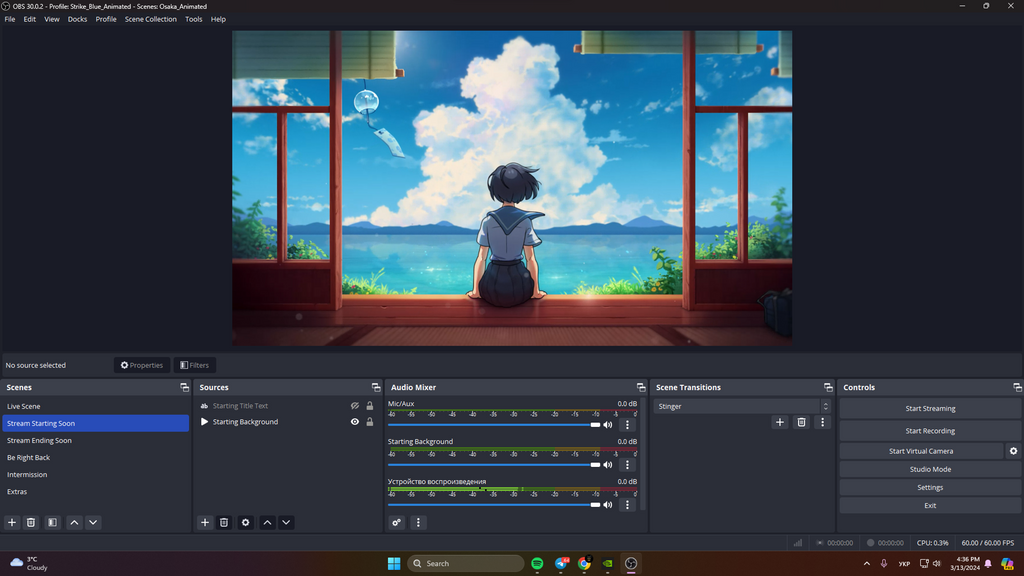
Selecting the right software for video recording and live streaming can be a complex task, given the variety of options available. In this article, we'll compare two widely used streaming tools, OBS and Shadowplay, to clarify their strengths and weaknesses. By examining their features side by side, we aim to equip you with the necessary insights to determine which software aligns best with your streaming goals. Join us as we delve into the details of OBS and Shadowplay, guiding you closer to making an informed choice for your streaming needs.
TL;DR
If you need a highly customizable streaming tool with full control over your layout, audio, and multi-platform support, OBS is the better choice. It’s powerful, free, and widely used by professional streamers, but it does require more setup and can be demanding on your CPU. On the other hand, if you just want a simple, no-fuss way to record or stream gameplay with minimal performance impact, Shadowplay is ideal. It’s lightweight, easy to use, and great for capturing high-quality clips—but it’s only available for NVIDIA users and lacks advanced customization.
|
Feature |
OBS |
Shadowplay |
|---|---|---|
|
CPU Impact |
Higher |
Lower |
|
Customization |
Highly customizable |
Limited to gaming overlays |
|
Editing Features |
Extensive |
Basic |
|
File Size |
Smaller, compressible during streaming |
Larger, compress after streaming |
|
Format Support |
Multiple, via FFmpeg |
MP4 only |
|
Compatibility |
Broad (multiple platforms) |
Twitch, YouTube, Facebook only |
|
Community Support |
Large and active |
Smaller, less-known |
|
Hardware Requirements |
No specific hardware required |
NVIDIA graphics card only |
|
Ease of Use for Beginners |
More complex setup required |
Simpler, more straightforward |
OBS

OBS stands for Open Broadcaster Software, and the name speaks for itself – it's a completely free open-source tool designed for an advanced live-streaming experience.
OBS is the antecedent to all modern encoders, which rightly can be considered one of the best in its niche. With no extra cost, it offers the ability to alter its code and scores of other expert features, a fully customizable interface, high performance, and compatibility with all your favorite streaming platforms like Twitch, YouTube, Facebook, and more.
Pros
-
Endless configuration options
-
Rearrangeable layout
-
Audio mixer with refined filters
-
Unlimited duration of video and audio recording with no watermark
-
Regular updates
-
Open-source code and active community
-
Lots of filters, such as auto color correction, chroma-key, image masking, cropping, and more
-
Relatively easy to set up
-
One-click going back and forth between scenes
-
Excessive customizable plugins
Cons
-
Lacks clarity when you set it up for the first time
-
A bit outdated user interface
-
No multistreaming option
Shadowplay

The next challenger in the race for the title of the best streaming software is Shadowplay, produced by NVIDIA, the company that has been leading the market for graphics processing units for a while. NVIDIA GeForce Shadowplay is a GeForce Experience add-on program that records gameplay while you play so that you can check it all later. It's surprisingly straightforward to use, whereas it captures videos with 4K quality and a 60 fps frame rate. The biggest benefits of Shadowplay are its competent usage of CPU resources, the capacity to record the most recent seconds of your gaming, and its free-of-charge basis.
However, it should be mentioned that Shadowplay functions exclusively with NVIDIA graphic cards and GeForce Experience and
is compatible only with YouTube, Twitch, and Facebook. So it's a solution for those who don't plan to use other platforms and are okay with these limitations.
Pros
-
High-quality screenshots
-
4k resolution of streams
-
Free to use
-
Hardware accelerated; hence it automatically runs when you start playing
-
Instantly shares gameplay to YouTube, Twitch, or Facebook
-
Gif-creator with the ability to share them on Google or Facebook without leaving the game
-
Automatic highlights with your best gaming moments
-
Compatible with custom graphic overlays
-
Stable and smooth performance
Cons
-
Only streams to YouTube, Twitch, and Facebook
-
Works with GeForce Experience for Windows
-
Works just with NVIDIA graphic cards
Comparison between OBS and Shadowplay
Let's inspect a few key distinctions between OBS and Shadowplay to see which is better for your needs.
Effect on CPU
OBS causes a tougher effect on CPU performance while running, even if you have limited frame rates. Shadowplay, in contrast, doesn't affect game performance so much. NVIDIA claims that typically it drops by 5%, but this number might go up to 10% for some games with higher demands. The difference isn't drastic, so if you are the lucky owner of a decent up-to-date PC, you won't even notice it!
Customization
OBS is the unconditional leader when it comes to customizability. Shadowplay is excellent in overlays, but it's aimed primarily at gaming and compatible with a limited list of games. In general, in whatever game you play, there are always extensive customization choices with OBS, but in the case of Shadowplay, everything isn't that easy.
Editing
Shadowplay has several editing features, but again, the number is a bit poor compared to the OBS range. If you crave professional looks, OBS stuns with overlays, hotkeys, widgets, and transitions from the never-ending list, always open to exploration and experiments.
File size
Compared to OBS recordings, ShadowPlay ones use more disk space. OBS allows compression while streaming, so you can substantially reduce output sizes without extra steps. Shadowplay files can be recompressed only after the broadcast ends, so it merely takes more time. However, you might not need to compress your videos because many streaming services will worsen the quality during the upload, so you should try to reduce their impact by refusing to compress the streams. In this particular case, there's no dramatic difference between OBS and Shadowplay.
Format
Shadowplay automatically uploads all the footage in MP4. In contrast, OBS provides an opportunity to use the GPU's NVENC hardware encoder chip, allowing you to choose literally any desired format supported on the FFmpeg library.
Compatibility
You can only use Twitch, YouTube, and Facebook with ShadowPlay. Additionally, using the Shadowplay screen recorder while streaming to Twitch isn't provided, so you'll need a second screen recording application. OBS' list of supported streaming services unleashes content creators and even offers to enter a custom platform if you cannot find your streaming destination among mentioned, so it's way ahead of its competitor.
Community
OBS is known for its vibrant community, making it simple to access any information you need on tech problems, tips, and tricks. It's incredibly receptive to user demands so that every user can suggest new enhancements through the request feature. Shadowplay has a smaller fanbase just because it's a less-known encoder, but you can manage to find step-by-step instructions and reviews, although they may be a little outdated.
In a nutshell
The choice of streaming software primarily depends on your demands and preferences. Still, generally, you must be sure that the program is fairly easy to use, meets your needs, and provides proper customer support. Shadowplay is an excellent option if you're a beginner streamer who yearns for a simple tool with an elegant layout. If you own the NVIDIA graphic card, plan to use only Twitch, YouTube, or Facebook, and don't need to record streams at once, Shadowplay fits all your parameters.
If you want your stream to look more professional, you should focus on OBS because it gives you almost absolute control over your streams. Both Shadowplay and OBS are free, but OBS doesn't have the abovementioned limitations, offers more customization freedom, and is more powerful and complex in most ways.
Check out comparisons of OBS vs. Xsplit, OBS vs. Streamlabs, and Streamlabs vs. StreamElements to dig deeper into the streaming software question and find your perfect solution.




